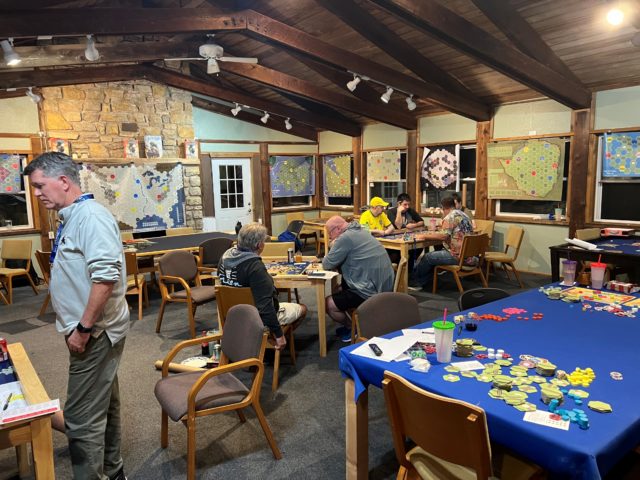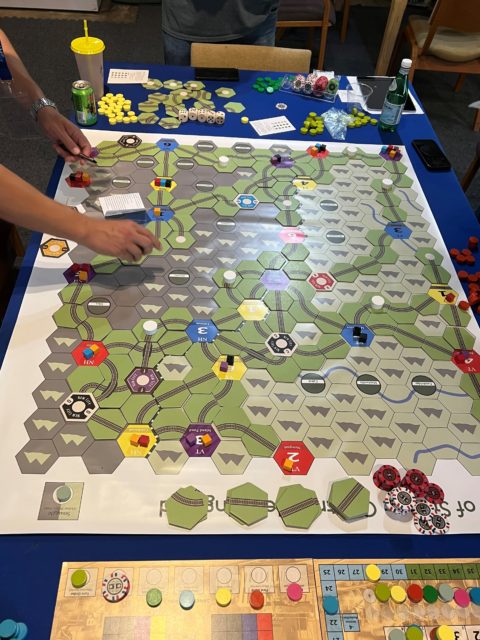I think anyone that has played board games enough to be reading this article understands the yearning which comes from not getting your favorite game(s) played more often. Twilight Imperium requires too much time and too many players; The Republic of Rome requires enough freaks that care about the intricacy of Ancient Roman politics; Die Macher requires exactly five people that want to argue about square tomatoes; Advanced Squad Leader requires to find another living, breathing human who will read the required 250+ pages of text before understanding the most basic of rules: the list goes on and on.
But what if I told you, every year in the early fall in Kansas City, Kansas, my dreams come true, and a gaming convention is held just for the purpose of playing my favorite game: Age of Steam?
For those unfamiliar, here’s the simplest explanation of Age of Steam ever: Players build a personal track network from different colored cities to other different colored cities, all with the goal of delivering colored cubes to their matching colored cities. However, your goal is not to be as efficient as possible with your deliveries; rather, it is to make a delivery as long as your Locomotive Level will allow, to maximize your Income gained (which is basically fancy victory points). When these deliveries are made, the cubes are removed off of the board, creating an ever-reducing pool of possible deliveries to make throughout the game.
This track network you are building, and always adding onto, must be paid for with liquid cash. This cash is acquired through two means: shares, and Income. At the start of every round, you can take out one share to gain $5, two to gain $10, and so on, up to 15 total shares throughout the game. Income, on the other hand, ticks up throughout the game as deliveries are made, and will gain you liquid cash so you can continue to expand your railroad empire.
There’s a couple of rubs here to make this all a bit… spicy. The first is, your railroad empire has expenses to deal with. The more loans you take out, and the more the delivery level of your train is increased, the more your expenses increase. Avid players are aware of this trap, and are hesitant to get a Rolls Royce of a train too early, to prevent their expenses from skyrocketing. But if you wait too late in the game to do it, then you’ll never have the train “strength” to deliver the longest possible route, which in most games, can quickly get you into an unrecoverable death spiral.
Another rub is the player order auction. In addition to needing money to pay for your track lay and operating expenses, you also need to have enough cash to compete for turn order during the player turn order auction. Want that juicy track lay? Who else does? Do I need to outbid everyone, or just David? The final rub of this game is, after the player turn order auction, each player (in this new turn order) gets to choose one rule breaker for the round: will you choose the ability to lay four track instead of three? What about a permanent increase to your Locomotive Level? What about the ability to lay an entirely new city onto the board?
This game, this system, was originally released in 2002. The original rules were developed for a map called Rust Belt, which is roughly the Midwest of the United States. Now though? There’s easily 150+ maps professionally and independently published for this game. And the best part of the community maps? Not only have I gotten to play a lot of them, but I’ve gotten to have beers and dinner with the designers of these maps.

Age of Steam Con happens at a small campground in Kansas City, Kansas. It is a three-day con, Friday – Sunday, with a bonus night on Thursday night for those who get into town early. The convention has somewhere between 50 and 75 people in attendance. The “convention hall” is literally a fully finished campground building with two main rooms, a kitchen, and four restrooms. There’s linoleum floors, wood panelling on the walls, baseboard heating, and two fireplaces. Outside the building is a large porch area that wraps around about a third of the building, providing enough space for picnic tables and a refrigerator (which inevitably gets filled to the brim with beer). The grounds of the con are absolutely dreamlike in their beauty. The building is surrounded by nature trails and old trees. The drive to get back to the building has many encounters with deer on or around the road. There’s nothing to hear when standing outside but the sounds of nature, and the curses of Age of Steam players playing.
The convention is run by two folx: Kevin McCurdy, and Chad DeSeon. Chad is the owner of BoardGameTables.com, and the convention hall is filled with their tables for us to play on. But do not be fooled! Chad is not just the owner of that company, but one amazing Age of Steam player, a stand-up guy, and one of the most passionate board gamers I know in the industry. He has told me some stories that I wish I could relay. Kevin is far too humble to admit this, but the main reason that Age of Steam has stayed as prominent as it has over the years. He has gotten many “figure heads” in the community into the game, both content creators that spread the love of the game through their content, and aspiring designers who have made their own Age of Steam maps that have gained popularity. Besides proselytizing the game, Kevin has designed many maps for the game, including Brummie Rails and Heavy Cardboard, both maps that Eagle-Gryphon Games have published with their most recent Deluxe version of Age of Steam.
In addition to these two, there’s one other main person of the con I’d like to shout-out: Kay. Kay is Chad’s mother-in-law, and former school lunch lady. See, the convention happens about 15 minutes away from food (or any civilization, for that matter). And some people stay in the adjoining campground, or carpool with others to get out to the con site every morning. So to prevent people wasting hours of their lives trying to figure out food for three days, Kay cooks for us all. Two and a half days of constant food. Literally constant, too. Lunch is over? Time to eat hors d’oeuvres until dinner. Is it MIDNIGHT? Well don’t worry, finger sandwiches were left out before she left for the day. The best part of it all, though, is getting to talk to Kay, and seeing her light up when you tell her just how freaking awesome the food is.
All that aside, let’s talk about some of these Age of Steam maps I got to play!
Benzene is a map designed by Hiromi Oikawa. Hiro is a Japanese game designer, and avid Age of Steam fan who travelled from Japan to the con to get to play Age of Steam all weekend. I didn’t get to play her map with her, but I was able to get to talk with her about it afterwards, which was so fun to get to do! Anyway, the premise of the map is simple: play Age of Steam, except every time you make a delivery, you put the cube you delivered in front of you instead of back into the random draw bag as per usual. Then, near the end of the round, you can make scientific chemicals with the cubes you’ve delivered, which lets you move up a separate, map-specific research track for some fun bonuses. While this is a simple rule change, as you may be able to imagine, the implications of this change are massive. Now I have to worry about long deliveries, and deliveries of certain colors? How do I balance that out? Do I care about the science track at all? Do I care about long deliveries at all?

Central New England is a map designed by Ted Alspach. Besides designing games like Castles of the Mad King Ludwig, Suburbia, and One Night Ultimate Werewolf, and running Bezier Games, Ted has designed some of the most popular and famous maps for Age of Steam. Central New England is technically two maps pushed together to make an extra large map for 7 – 8 players, that essentially combines the rules of both maps. However, the main extra rule that Central New England has that its separate maps doesn’t is that deliveries have to be made across the central dividing line, which is the border between New Hampshire and Vermont. Oh, and players cannot use the track of others! This makes the center of the map incredibly tight and bloody, and oftentimes this map leads to 1 – 3 players being out pretty early (aka me). It was an absolute mess, and I don’t know if I’d ever do it again, but I certainly found the dynamic of a seven player knife fight quite entertaining.
The last map I want to talk about is Denmark, designed by J. C. Lawrence (an 18xx designer and avid fan of that system). The thing is, I don’t really know what to even say about this map. It was the last map I played for the weekend, and the three of us that were playing were exhausted and loopy. It only took three rounds before I went bankrupt and was eliminated. Was the map good? Probably, I don’t know. But it’s truly just a reminder of why we play games in the first place. Jac, who introduced the map, was a complete stranger to me. And after that game, we chatted a ton just about who we are, and where we came from. We laughed until I was crying. In an earlier game, Scott (who I went out there with) and I met a guy named Tom. Tom is one stand-up guy, but mainly so funny. I love that guy. Saturday and Sunday night, the three of us played Haggis, a little three player card game. Honestly, the sheer hilarity mixed with bonding that comes from the late night exhaustion of board gaming creates a space of community and belonging unmatched by any other sphere I’ve ever been a part of.
Age of Steam Con is the best time I’ve ever had in my life. Hands down. But it has nothing to do with the game, even though it is my favorite game. If I got to be in that atmosphere, with those same people, I’d even play my least favorite game all weekend.
Especially if Kay was still cooking.
This sounds like so much fun, Bailey! It almost—almost—makes me want to learn Age of Steam.